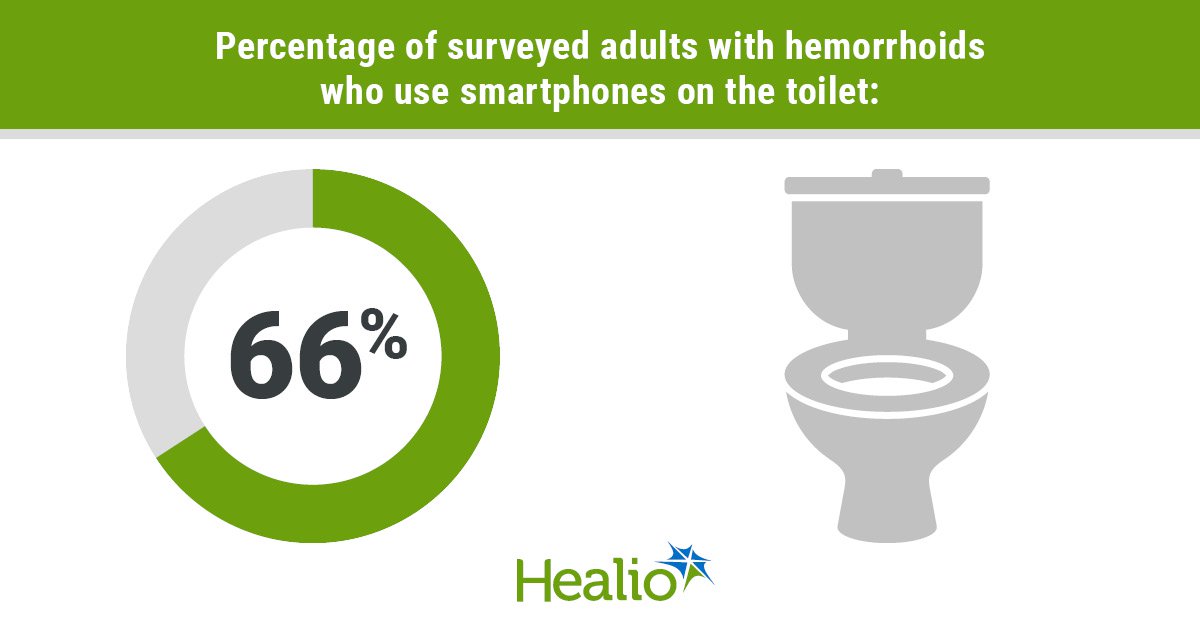September 22, 2025
3 min read
Key takeaways:
- Survey found 66% of respondents with hemorrhoids used a smartphone while on the toilet.
- People who used their smartphones in the bathroom were five times more likely to spend more than 5 minutes per trip.
Smartphone use on the toilet — which often included reading the news or scrolling through social media — was associated with a 46% increased risk for hemorrhoids, according to a cross-sectional study published in PLOS One.
“The bathroom should be used for the purpose it was intended for,” Trisha Pasricha, MD, MPH, study author and director of the Institute for Gut-Brain Research at Beth Israel Deaconess Medical Center, told Healio. “Just like we advise patients not to scroll in bed when they’re trying to sleep because it can lead to insomnia, scrolling on the toilet distracts them from the task at hand.”

Data derived from Ramprasad C et al. PLoS One. 2025;doi:10.1371/journal.pone.0329983.
Although anecdotal evidence suggests prolonged sitting on the toilet is a risk factor for hemorrhoids, no studies have previously linked smartphone use with hemorrhoids, according to researchers.

Trisha Pasricha
“The advice we had been giving patients to limit time spent in the bathroom was based on older studies from decades ago, back when reading the newspaper in the bathroom was the norm,” Pasricha said. “[Smartphones have] completely changed our bowel habits, just as they have changed so many other aspects of our daily lives. It was about time we studied that better.”
Pasricha and colleagues surveyed 125 adult patients undergoing screening colonoscopy at Beth Israel Deaconess Medical Center to gather information about demographics, lifestyle factors, dietary habits and smartphone use while on the toilet. Participants also completed the Rome IV questionnaire to assess gastrointestinal function and symptoms of bowel disorders.
The researchers reviewed endoscopic reports from each patient’s colonoscopy to determine the presence of hemorrhoids.
Results showed 66% of participants used smartphones while on the toilet. Those who did were younger (mean age, 55.4 years vs. 62.1 years; P = .001) and engaged in significantly less exercise per week (P = .017). No other differences were identified in baseline characteristics and Rome IV criteria for irritable bowel syndrome or functional constipation.
More than half (55.4%) of those who used their smartphones on the toilet did so most of the time, and more than a third (37.3%) of users spent more than 5 minutes on the toilet per trip compared with 7.1% of nonusers.
Reading the news was the most frequently reported smartphone activity (54.3%), followed by social media (44.4%).
Overall, 43% of respondents had hemorrhoids. After controlling for risk factors and other baseline characteristics, the researchers found that smartphone use on the toilet was independently linked to a 46% increased risk for hemorrhoids (P = .044).
“About two-thirds of our study’s participants brought a smartphone into the bathroom with them, and people who used their smartphones in the bathroom were about five times more likely to spend more than 5 minutes per trip to the bathroom despite no baseline differences between these groups in terms of constipation or straining,” Pasricha said.
The researchers acknowledged study limitations, including its cross-sectional design, which could not establish causation, as well as reliance on self-reported data and use of an older study population that may not represent the general population.
Future studies should assess larger, more diverse patient populations, Pasricha noted.
She also encouraged health care providers to ask patients about smartphone use in the bathroom, which is likely not a common line of questioning during visits.
For patients who are unwilling to completely stop using smartphones on the toilet, Pasricha recommended setting a timer for 5 minutes, or setting a “two-TikTok limit.”
“After two social media videos, if you’re not making progress with your bowel movement, take a breather, walk around and come back later,” she said. “Many people need to read something to relax and have a comfortable bowel movement, which is perfectly fine and normal. But bring something old school, like a magazine with short-bite reads that isn’t expressly designed to make you lose all sense of time like social media is.”
For more information:
Trisha Pasricha, MD, MPH, can be reached at tpasrich@bidmc.harvard.edu.









